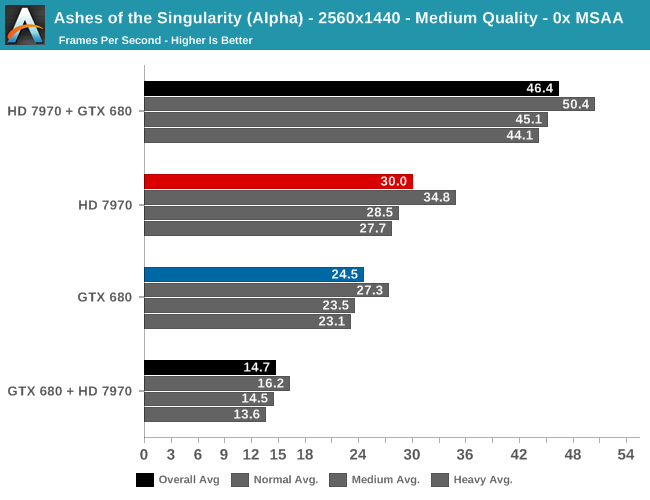GeForce + Radeon: Previewing DirectX 12 Multi-Adapter with Ashes of the Singularity
by Ryan Smith on October 26, 2015 10:00 AM ESTAshes GPU Performance: Single & Mixed 2012 GPUs
While Ashes’ mutli-GPU support sees solid performance gains with current-generation high-end GPUs, we wanted to see if those gains would extend to older DirectX 12 GPUs. To that end we’ve put the GeForce GTX 680 and the Radeon HD 7970 through a similar test, running the Ashes’ benchmark at 2560x1440 with Medium image quality and no MSAA.

First off, unlike our high-end GPUs there’s a distinct performance difference between our AMD and NVIDIA cards. The Radeon HD 7970 performs 22% better here, just averaging 30fps to the GTX 680’s 24.5fps. So right off the bat we’re entering an AFR setup with a moderately unbalanced set of cards.
Once we do turn on AFR, two very different things happen. The GTX 680 + HD 7970 setup is an outright performance regression, with performance 40% from the single GTX 680 Ti. On the other hand the HD 7970 + GTX 680 setup sees an unexpectedly good performance gain from AFR, picking up a further 55% to 46.4fps.
As this test is a smaller number of combinations it’s not clear where the bottlenecks are, but it’s none the less very interesting how we get such widely different results depending on which card is in the lead. In the GTX 680 + HD 7970 setup, either the GTX 680 is a bad leader or the HD 7970 is a bad follower, and this leads to this setup spinning its proverbial wheels. Otherwise letting the HD 7970 lead and GTX 680 follow sees a bigger performance gain than we would have expected for a moderately unbalanced setup with a pair of cards that were never known for their efficient PCIe data transfers. So long as you let the HD 7970 lead, at least in this case you could absolutely get away with a mixed GPU pairing of older GPUs.










180 Comments
View All Comments
AndrewJacksonZA - Tuesday, October 27, 2015 - link
Did you try running three cards Ryan?BrokenCrayons - Tuesday, October 27, 2015 - link
It's pretty interesting stuff, but I think most of the people who buy computing hardware could care less about the performance of a pair of high end graphics processors that are individually priced well above the cost of a nice laptop. What's more substantial in this is the ability to make use of an iGPU whena dGPU is present in the system to obtain a better overall user experience. Very, very few people are going to bother throwing away money to buy even one graphics card at a cost of over $400 let alone two and then also soak up the cost of the components necessary to support their operation. I can't imagine developers, those in control of whether or not this new feature gets any support in the industry, are going to invest much money by writing code to support such a small subset of the overall market. In the end, what DX12 might do is have the exact opposite effect of what we're predicting...it could ultimately kill off high end multi GPU setups as impractical and wholly unsupported by game production studios. The most I'd see this ever doing is making the i+dGPU scenario practical. Everything else seems a little too expensive to implement for a limited market of large desktop computers that are rapidly fading away as small form factor and mobile devices replace them.diola - Tuesday, October 27, 2015 - link
Hi, after connecting the cards in mainboard and install the drivers, you need something else to work?I was unable to recognize the second card when the first is from AMD and the second from Nvidia.Wunkbanok - Tuesday, October 27, 2015 - link
How does this multi-adapter thing works? can i use a new card with an older card and get any improvement? wich cards are supported?dray67 - Tuesday, October 27, 2015 - link
I'm very tempted to give the Ashes alpha a try, I've recently upgraded from a 680 to a 980 ti and I like the idea of a linked setup, but theres so many questions, the main one being compatibility with other hardware, motherboards etc.I can't help but think that the bigger the disparity between cards the less you'd gain but either way I like where this is going (giggly).
Valantar - Tuesday, October 27, 2015 - link
I really wish you would take this one step further and test combinations of new and old cards - Fury X + 7970/GTX 680 and 980 Ti + GTX 680/7970 would be the really interesting combinations here. Also, far more relevant for most gamers looking to upgrade at some point in the next few years.loguerto - Tuesday, October 27, 2015 - link
I would like to mention an off-topic argument:the kepler gtx 680 as it's time was constantly outperforming the GCN 1.0 7970, and was on pair with the 7970 ghz edition. Now we have the the 7970 non ghz edition outperforming the gtx 680 by 20%. It's just a fact that proves how AMD cards compared to Nvidias.
Clone12100 - Tuesday, October 27, 2015 - link
Why no comparison of the older cards with the newer cards? Like a 7970 with a 980tiWhisperingEye - Tuesday, October 27, 2015 - link
Because they are using Alternate Frame Rendering. This means that the slowest card drives the set. So your new $400 card will go at the speed of your (now) $150 card.Oxford Guy - Friday, October 30, 2015 - link
Would have liked to have seen the 290X or 390X.